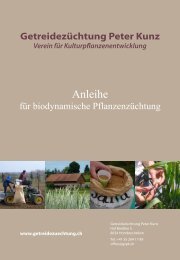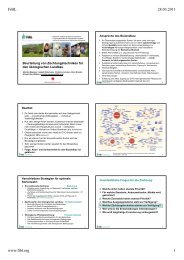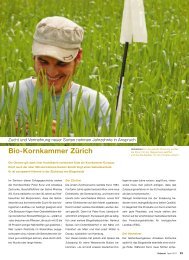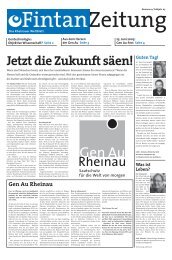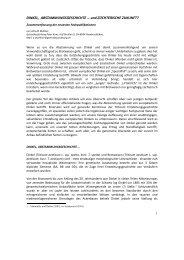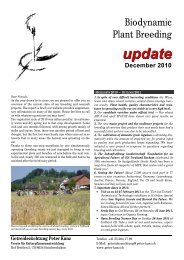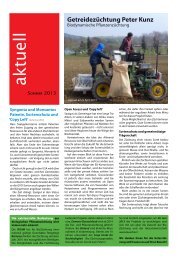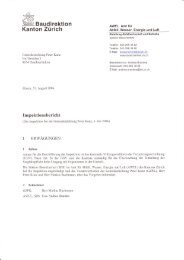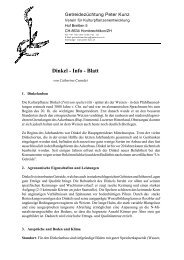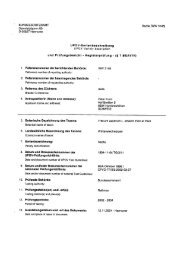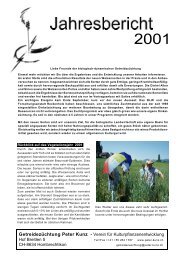Jahresbericht GZPK_2011_e_web - Getreidezüchtung Peter Kunz
Jahresbericht GZPK_2011_e_web - Getreidezüchtung Peter Kunz
Jahresbericht GZPK_2011_e_web - Getreidezüchtung Peter Kunz
Create successful ePaper yourself
Turn your PDF publications into a flip-book with our unique Google optimized e-Paper software.
Annual Report<br />
<strong>2011</strong><br />
<strong>Getreidezüchtung</strong> <strong>Peter</strong> <strong>Kunz</strong><br />
Association for crop development<br />
Biodynamic plant breeding<br />
Organic food for 7 billion<br />
people?<br />
Finally, in November <strong>2011</strong> the magic<br />
mark of 7 billion human beings living<br />
on earth was reached: This event got<br />
widely covered by the media, always<br />
with an emphasis on the need for an<br />
increase in food production through<br />
further intensification of agriculture, i.e.<br />
investment into more efficient agricultural<br />
technology, chemical fertilizers,<br />
herbicides and pesticides. Even “NZZ<br />
am Sonntag”, one of the main Swiss<br />
newspapers, concluded that the feeding<br />
of 7 billion human beings won’t<br />
work without agricultural gene technology.<br />
It seems that “NZZ am Sonntag” is<br />
not quite up-to-date: With the presently<br />
produced amount of food, even 7.5<br />
billion people could be easily nourished.<br />
A further intensification of agriculture<br />
will by no means solve – but on<br />
the contrary aggravate current problems<br />
of global food security. Taken<br />
alone the amount of cereals that is used<br />
as feed in animal production would<br />
suffice to nourish half of today’s world<br />
population! Genetically modified (GM)<br />
crops, which are often pictured as<br />
“magic bullets” in the complex issue of<br />
food security do not offer sustainable<br />
solutions to the problem, but are mere<br />
examples of a (for some) convenient<br />
technology: Around the world, GM<br />
crops are now grown on millions of<br />
hectares of agricultural land. None of<br />
these crops were developed in order to<br />
improve yields and thereby the amount<br />
of food available to the human population.<br />
They were mainly developed to<br />
support monocultural agriculture ignoring<br />
the important principle of crop rotation,<br />
which in organic farming is used<br />
to maintain soil fertility. Additionally,<br />
patents (and the respective licenses) on<br />
GM crops push farmers into dependencies<br />
on multinational agro-businesses.<br />
Millions of small-scale organic farms<br />
show that there ARE alternatives: Organic<br />
farming constantly evolves and<br />
does proof that sufficient amounts of<br />
food can be produced while at the<br />
same time managing water resources,<br />
biodiversity and soil fertility in a sustainable<br />
way. Organic agriculture has<br />
the potential to produce enough food<br />
for all of us and – equally important –<br />
offers a healthy and intact environment,<br />
cultural identity and locally rooted sustainable<br />
development of individual regions.<br />
Contents:<br />
Definition of OrganicBreeding 2<br />
Financing of OrganicBreeding 3<br />
Financing of <strong>GZPK</strong> 4<br />
News of <strong>GZPK</strong> projects 4<br />
Construction of new workspace 8<br />
<strong>Getreidezüchtung</strong> <strong>Peter</strong> <strong>Kunz</strong><br />
Hof Breitlen 5<br />
8634 Hombrechtikon<br />
Switzerland<br />
Tel: +41 55 264 17 89<br />
www.getreidezuechtung.ch<br />
office@gzpk.ch<br />
<strong>Getreidezüchtung</strong> <strong>Peter</strong> <strong>Kunz</strong> is a registered non-profit association.<br />
Donations to our projects are tax-deducible.<br />
(Commercial Register CH-020-6.000.558-4).<br />
CHF: 84-34345-2 (Postfinance)<br />
€: IBAN DE47 4306 0967 4013 3967 00 / BIC GENODEM1GLS (GLS Bank<br />
Bochum)
Sativa Rheinau AG<br />
Organic agriculture needs complete<br />
supply with organic seeds<br />
and organically bred varieties.<br />
Sativa Rheinau AG, by offering a<br />
large and constantly growing<br />
range of different organic seeds<br />
contributes to that goal: The<br />
range of products currently spans<br />
several hundred different vegetable<br />
varieties, herbs, flowers, but<br />
also cover crops, fodder maize,<br />
clover grass mixes, and cereals.<br />
All crossings are directly on<br />
the field. The emasculated<br />
flowers are covered with paper<br />
bags to protect them from<br />
undirected fertilization with<br />
air-born pollen.<br />
Sowing the future! gets bigger<br />
The initiative continues to expand:<br />
Taken this year alone, Sowing the<br />
future! took place on 96 fields in<br />
11 countries to put a strong sign<br />
against the use of agricultural<br />
gene technology. In the following<br />
countries Sowing the Future!<br />
happened for the first time in<br />
<strong>2011</strong>: Italy, Finland and Sweden.<br />
Bioverita - Varieties originating<br />
from OrganicBreeding<br />
Besides breeders and marketing<br />
businesses, also BioSuisse and<br />
Demeter Schweiz became members<br />
of „Bioverita”. Varieties<br />
originating from OrganicBreeding<br />
and products developed out of<br />
these qualify for „Bioverita” labeling.<br />
<strong>GZPK</strong> on Facebook<br />
Our official Facebook page regularly<br />
provides news in and<br />
around the <strong>GZPK</strong>. Join us and<br />
share our exciting experiences in<br />
the field or OrganicBreeding!<br />
www.facebook.com/getreidezuechtung<br />
Seed material and OrganicBreeding - a central topic<br />
OrganicBreeding is not a luxury activity taking place exclusively in rich countries<br />
of the northern hemisphere. On the contrary: OrganicBreeding develops principles<br />
and pictures with many practical experiences how decentralized seed distribution<br />
and supply systems can function.<br />
BioSuisse - Supporting and defining OrganicBreeding<br />
The federal council’s response to the parliamentary proposition of Maya Graf<br />
(Grüne BL, „Förderung der Züchtung von Biosaatgut“) requesting public financing<br />
of OrganicBreeding was the following: Without a mandatory definition of the term<br />
“OrganicBreeding” – which was not available by then – the proposition could not<br />
be further processed. Around the same time in autumn <strong>2011</strong>, BioSuisse delegates<br />
were requesting the support of OrganicBreeding by its umbrella organization.<br />
These two requests had the effect that OranicBreeding turned into a major topic of<br />
the federation and a work intensive time period: Within half a year, all parties involved<br />
(organizations; research institutes, e.g. FiBL; farmers, breeders etc.) developed<br />
a common basis and agreed on a mandatory definition of Organic Breeding.<br />
Hence, some kind of OrganicBreeding “constitution” could be adopted which sets<br />
out the precise definition of the term “OrganicBreeding” and clarifies its goals. FiBL<br />
further expanded the discussion on methods suitable for OrganicBreeding and published<br />
a summary of the results as “basic principles” of OrganicBreeding methods in<br />
a corresponding paper. These jointly developed basic principles serve to evaluate<br />
and categorize breeding methods with regard to their value for OrganicBreeding. It<br />
will be much easier now to find out whether the use of a new or slightly changed<br />
method in OrganicBreeding can be supported. With a precise definition of the term<br />
“OrganicBreeding”, the foundations were laid to finally request also public financing<br />
in order to promote the organic breeding of seed.<br />
Wheat quality <strong>2011</strong><br />
The MRI (Max Rubner Institut für Sicherheit und Qualität bei Getreide Detmold)<br />
highlighted the outstanding grain quality of Scaro and Wiwa this year: These two<br />
varieties performed better than average compared to all other organic wheat varieties<br />
regarding protein and gluten content, protein quality, flour yield, and baking<br />
volume (bioland 11/<strong>2011</strong>). Scaro and Wiwa enjoy great popularity not only<br />
amongst farmers but also – for the above mentioned reasons – amongst millers,<br />
bakers and consumers.<br />
2
Collaboration with the Coop<br />
Sustainability Fund<br />
An important collaboration with Coop<br />
has been existing for over 9 years now:<br />
Coop processing businesses (mills and<br />
bakeries) use grains harvested from<br />
new <strong>GZPK</strong> varieties for the production<br />
of flour and organic „Bioverita“ labeled<br />
breads (www.bioverita.ch). At<br />
the same time, the Coop Sustainability<br />
Fund supports several research projects,<br />
including the pre-breeding of<br />
wheat and spelt varieties to improve<br />
nitrogen use efficiency and seed multiplication.<br />
Currently, a further 3 year<br />
agreement to support <strong>GZPK</strong> is prepared.<br />
Multiplication of basic seed<br />
and breeder‘s seed<br />
The demand for breeder’s seed of<br />
<strong>GZPK</strong> varieties has continued to increase<br />
across countries. Sativa Rheinau<br />
AG is our most important partner regarding<br />
seed multiplication and distribution.<br />
The complete seed multiplication<br />
for Switzerland and a small-scale<br />
multiplication of pre-basic seed are organised<br />
and taken care of by Sativa<br />
Rheinau AG. Unfortunately, due to the<br />
small amounts produced the provision<br />
of pre-basic seed is still not costcovering.<br />
In Germany, the multiplication of seed<br />
is coordinated by Thomas Leibinger of<br />
Bioland Handelsgesellschaft Baden-<br />
Württemberg. In the various states,<br />
seed production takes place at local<br />
multiplication organisations and businesses.<br />
Crossings in maize are technically<br />
much easier compared<br />
to wheat and spelt. Maize<br />
fields, however, offer working<br />
conditions at sometimes tropical<br />
temperatures.<br />
France and Belgium are supplied<br />
with our wheat and spelt varieties by<br />
the seed companies Lemaire Deffontaines<br />
in Auchy-les-Orchies and Pinault<br />
Bio SA in Pleugueneuc<br />
Farm saved seed - an unclear<br />
situation<br />
Our varieties enjoy great popularity:<br />
Their excellent spike health accounts for<br />
a correspondingly high seed quality<br />
and the possibility to save seed for the<br />
next round of planting. In principle, we<br />
support the saving of seed material by<br />
farmers! We do not aim for a collaboration<br />
with the Saatgut-Treuhand, which<br />
normally takes care of seed licensing.<br />
Seed licences paid on a voluntary basis,<br />
however, are not an option any<br />
longer: This way, cost coverage on our<br />
side as well as a continuous financial<br />
support of OrganicBreeding by the<br />
variety users cannot be guaranteed.<br />
Licences for farm saved seed could be<br />
taken care of by various organic cultivation<br />
associations, maybe even within<br />
the existing structures of the Saatgutfonds:<br />
By implementing, e.g. contributions<br />
for the cultivated area of farm<br />
land, OrganicBreeding initiatives could<br />
supported in a targeted way. Then, one<br />
option to considerably reduce the cost<br />
for farmers would be to abolish the<br />
general licences on breeder’s seed.<br />
Right now, these possibilities are mere<br />
suggestions in an ongoing discussion<br />
process amongst representatives of<br />
various associations. From the breeders`<br />
point of view, it would be desirable<br />
to agree on a standardized solu-<br />
3<br />
Financing Organic<br />
Breeding<br />
Currently, most OrganicBreeding<br />
projects are based on the private<br />
initiative of single persons who<br />
have strong bonds with the biodynamic<br />
movement. In addition to<br />
their duties connected to plant<br />
breeding directly, these people<br />
need to take care of the funding<br />
from year to year, a time and<br />
energy consuming activity. OrganicBreeding<br />
projects usually<br />
last and have to be planned over<br />
a time period of 10 to 15 years.<br />
Therefore, planning reliability<br />
cannot be guaranteed if funding<br />
is allocated only on a short term<br />
basis, e.g. 1-3 years. As discussed<br />
earlier, the idea of OrganicBreeding<br />
as a central topic<br />
in organic farming, has become<br />
popular: OrganicBreeding provides<br />
for the suitable varieties<br />
and at the same time makes a<br />
vital contribution to biodiversity<br />
and sustainable crop development.<br />
OrganicBreeding serves a<br />
public interest, and therefore deserves<br />
financial support on broad<br />
(and public) basis.<br />
Fund for Crop Plant Development<br />
The long-term oriented goals of<br />
OrganicBreeding, putting a<br />
strong focus on sustainability in its<br />
various aspects, is in stark contrast<br />
to the current mode of funding,<br />
which is allocated on a shortterm<br />
basis only and has to be<br />
newly applied for each year. The<br />
Fund for Crop Plant Development<br />
was established in 2009 as a<br />
non-profit initiative by <strong>Peter</strong> <strong>Kunz</strong>.<br />
With the help of donations etc.<br />
the Fund aims to support OrganicBreeding<br />
projects on a longterm<br />
basis. For more Information:<br />
www.fondskulturpflanze.ch or Tel.<br />
+41 55 264 17 88.<br />
Saatgutfonds Zukunftsstifung<br />
Landwirtschaft<br />
For more than 11 years now, this<br />
fund of the non-profit GLS trust<br />
represents an important instrument<br />
to support OrganicBreeding<br />
initiatives. Donations of private<br />
persons, business organisations<br />
and trusts, which are collected on
tion across associations. A first exchange<br />
of ideas took place at a conference<br />
on OrganicBreeding of the<br />
BÖLW (Bund ökologische Lebensmittelwirtschaft)<br />
this October: OrganicBreeding<br />
is a central topic in organic<br />
farming. A closer collaboration<br />
with the various organic cultivation associations<br />
would great!<br />
Stop to support multi-national<br />
seed companies!<br />
Wherever conventionally bred plant<br />
varieties are used, multi-national seed<br />
companies are earning their substantial<br />
share: Per hectare wheat € 10-15, per<br />
ton flour € 3-4, per kg bread Ct 5-10<br />
flow back to these companies with<br />
agendas that do not comply at all with<br />
any aspects of sustainability. It would<br />
be a major step already, if the majority<br />
of organic farms and processing businesses<br />
would use OrganicBreeding<br />
varieties and thereby financially support<br />
OrganicBreeding. A close cooperation<br />
of breeders, farmers, processing<br />
and marketing businesses would represent<br />
our common responsibility for the<br />
future of crop plants.<br />
Financing of <strong>GZPK</strong>‘s OrganicBreeding<br />
projects<br />
2012<br />
<strong>2011</strong> was characterized by a drastic<br />
financial loss due to Euro crisis.<br />
Whereas more than half of our yearly<br />
budget is acquired in Euro, most of the<br />
costs have to be paid in Swiss Francs.<br />
As in the year before, the financial loss<br />
equates to the yearly salary of a <strong>GZPK</strong><br />
employee. Due to a very generous and<br />
unexpected donation by a funding<br />
agency which strongly supports our<br />
ideas, we could evade massive reductions<br />
in expenditures, i.e. cuts in the<br />
funding of individual projects. We hope<br />
to close the year with a more or less<br />
balanced financial statement. For 2012,<br />
we calculate with a total outlay of €<br />
750‘000 to CHF 900‘0000. This increase<br />
in expected costs relates to the<br />
growing size and number of projects,<br />
e.g. in maize, sunflower, grain legumes<br />
and wheat quality analysis. The financial<br />
returns from variety licenses are<br />
expected to cover 9 to 10% of our total<br />
costs. The remaining 90% have to be<br />
covered by private donations, as well<br />
as donations by businesses, funds and<br />
cultivation associations, financing which<br />
has to be newly acquired from year to<br />
year. To date (December <strong>2011</strong>), the<br />
financial commitments offered so far<br />
equate to a fifth of the calculated<br />
budget for 2012. We strongly rely on<br />
financial support by donations on a<br />
continuous basis. More than 250 private<br />
donors express their loyalty by<br />
supporting us regularly since many<br />
years.<br />
News OrganicBreeding<br />
projects<br />
Pre-breeding - Generating,<br />
refining and maintaining<br />
biodiversity<br />
The breeding of new plant varieties<br />
strongly relies on plant biodiversity.<br />
OrganicBreeding often aims for different<br />
plant characteristics than conventional<br />
plant breeding; hence, the active<br />
re-generation, refinement and maintenance<br />
of biodiversity plays an important<br />
role. The first 6-8 years of the<br />
breeding process are exclusively devoted<br />
to the re-generation of diversity,<br />
and refinement by selection and genetic<br />
fixation of desired traits. In parallel,<br />
evaluation of the newly developed lines<br />
starts. New lines can be either used in<br />
further crossings and/or are included<br />
into the variety test trial set. Important<br />
criteria for new lines are: Disease resistance<br />
and drought tolerance, certain<br />
yield and quality characteristics, and a<br />
strong ability to adopt to changing cultivation<br />
and climate conditions; the latter<br />
represents a big challenge to our<br />
crops and breeders!<br />
Quality Wheat Breeding<br />
Due to its excellent baking quality<br />
characteristics, our wheat variety Wiwa<br />
has become the quality standard for<br />
new candidate varieties. The original<br />
crossing, which lead to the generation<br />
of Wiwa, was done 21 years ago in<br />
1990 by <strong>Peter</strong> <strong>Kunz</strong>. It is difficult to<br />
beat Wiwa in its quality, however, we<br />
strive for improvements regarding yield,<br />
and resistance to lodging (under more<br />
intensive cultivation) as well as rust:<br />
Rust occurrence, in particular on early<br />
ripening sites, seems to have increased<br />
over the last couple of years. This year,<br />
two new wheat varieties, A7T.9 and<br />
APW.1110 were included into the official<br />
variety trials in Switzerland. Both,<br />
A7T.9 and APW.1110 are candidates in<br />
the Top quality class. APW.1110<br />
4<br />
a yearly basis, are used to support<br />
crop, vegetable and fruit<br />
breeding initiatives located in<br />
more then 20 different locations<br />
throughout Europe. This fund allowed<br />
for the expansion of OrganicBreeding<br />
initiatives during<br />
the last couple of years, initiatives<br />
w h i c h n e e d t o b e f u r t h e r<br />
strengthened and intensified. For<br />
more information:<br />
www.saatgutfonds.de<br />
showed an additional increase in yield<br />
level over the 3 year test trial period.<br />
Early ripening, hardy<br />
spring wheat varieties<br />
Whenever winter wheat follows<br />
maize or sugar beet in the crop rotation<br />
cycle, the time point for planting is<br />
shifted towards the end of the year. At<br />
the same time, fast growing, early ripening<br />
spring wheat varieties for areas<br />
with dry summers are demanded. For<br />
some years now, a very small spring<br />
wheat project has been running in parallel<br />
to the winter wheat projects: This<br />
year we finally could select around 10<br />
very promising lines, which will be included<br />
into next year’s test trial set.<br />
Pigment wheat varieties<br />
Anthocyanes and carotenoides (Carotin,<br />
Pro-Vitamin A precursors) are<br />
natural pigments and secondary plant<br />
metabolites. Due to their function in<br />
plants and human nutrition they are<br />
suggested to have positive effects on<br />
human health: Anthocyanes, for example,<br />
are reducing free radicals in the<br />
body and therefore play an important<br />
role in cancer prevention. Improved<br />
amino acid patterns in pigment wheat<br />
varieties additionally account for a high<br />
nutritional value. In the breeding nursery<br />
of <strong>GZPK</strong>, a whole range of wheat<br />
lines were selected due to their red and<br />
yellow grain colour. We expect them to<br />
contain elevated anthocyane and carotin<br />
levels, respectively. The most<br />
promising of these were included into<br />
our test trial set and will be evaluated<br />
regarding agronomic as well as quality<br />
characteristics. Ideally, the best lines<br />
will be registered as niche varieties or<br />
even be included into official variety<br />
tests.
Quality wheat varieties for<br />
extensive and dry sites<br />
The availability of drought tolerant<br />
wheat varieties will continue to gain<br />
weight with predicted changes in climate<br />
conditions. A shortage in water<br />
supply during the phase of grain filling<br />
and ripening has a negative impact on<br />
yield as well as processing quality. Our<br />
project exploits the fact that wheat in<br />
Rheinau has to be irrigated under normal<br />
conditions. Lines selected during<br />
the pre-breeding phase are grown in<br />
Rheinau without irrigation and are<br />
evaluated regarding yield, quality and<br />
disease resistance under dry conditions.<br />
These results are compared to their<br />
performance under „normal” (i.e. sufficient<br />
water supply) conditions. The experimental<br />
system is very simple in design<br />
and therefore cost-efficient. It’s<br />
informative value, however, depends<br />
on the yearly weather conditions and<br />
fluctuations in precipitation.<br />
Common bunt resistance<br />
breeding<br />
The establishment of a broad range of<br />
resistances against common bunt („Steinbrand”<br />
or „Stinkbrand”, T. caries) –<br />
an ancient fungal grain disease – is a<br />
very important task for OrganicBreeding.<br />
Unfortunately, resistance breeding<br />
is a very time consuming and complex<br />
process. Apart from the introgression of<br />
bunt resistances into wheat, we also try<br />
to find resistant spelt varieties. <strong>2011</strong><br />
exemplified that not only common bunt,<br />
but also dwarf bunt („Zwergsteinbrand”,<br />
T.controversa) resistances are<br />
urgently needed: Dwarf bunt infested<br />
large areas, even at low altitudes. In<br />
practice this would mean a doubling of<br />
the already high work load. Right now,<br />
the financial means as well as sufficient<br />
manpower and know-how are missing<br />
in order to implement an additional<br />
dwarf bunt resistance breeding scheme.<br />
Adequate technical equipment would<br />
be available, however.<br />
Spelt variety breeding<br />
New spelt varieties do not enjoy the<br />
same acceptance by processing and<br />
marketing agencies as new wheat varieties.<br />
One reason for this could be the<br />
very specific expectations towards<br />
spelt’s nutritional qualities. Most of our<br />
ancient spelt varieties will not survive<br />
the changes predicted for the next 20-<br />
30 years in climate and cultivation<br />
techniques – if not even the most serious<br />
deficiencies are corrected by OrganicBreeding:<br />
Missing spelt biodiversity<br />
causes high susceptibility for certain<br />
diseases and the high lodging incidence<br />
has negative impacts on grain quality.<br />
For the farmer, spelt cultivation is connected<br />
to financial risk. Besides our<br />
breeding efforts to improve certain<br />
agronomic traits, it is of utmost importance<br />
that spelt keeps its special nutritional<br />
quality: Spelt is sometimes better<br />
tolerated than wheat. In all spelt varieties<br />
newly developed over the last 25<br />
years at <strong>GZPK</strong>, this characteristic has<br />
been maintained. Especially in France<br />
and Belgium our spelt varieties enjoy<br />
great popularity!<br />
New spelt variety: Zürcher<br />
Oberländer Rotkorn<br />
Our new spelt variety „Zürcher<br />
Oberländer Rotkorn” (ZOR) was approved<br />
in the official variety trials; from<br />
now on, ZOR seeds can be distributed<br />
throughout Europe. This early ripening<br />
variety (4 days faster than conventional<br />
spelt varieties) brings about great improvements<br />
regarding lodging incidence,<br />
plant health and yield potential<br />
(117%). Not only farmers, but also<br />
bakers will be pleased by ZOR`s processing<br />
qualities: The flour can take up<br />
more than 6% water without resulting<br />
in a sticky dough, as it is the case for<br />
conventional spelt varieties. Thereby,<br />
spelt bread remains significantly longer<br />
fresh.<br />
Spring spelt varieties<br />
This year, for the first time, 250<br />
spring spelt gene bank accessions<br />
originating from around 30 different<br />
countries were planted in Darmstadt.<br />
The diversity in forms is huge, at the<br />
same time however, the accessions are<br />
simply not adapted to nowadays` cultivation<br />
conditions: The whole experiment<br />
was flattened to ground by heavy<br />
rains. Many crossings were realized in<br />
spring spelt this year, on the one hand<br />
to mix our breeding material and on<br />
the other hand to generate the future<br />
basis for the selection of a spelt variety<br />
which can be planted as winter as well<br />
as spring type.<br />
Tolerance of wheat and<br />
spelt<br />
5<br />
Spelt is closely related to wheat. Interestingly,<br />
spelt is ascribed a better tolerance,<br />
from a nutritional point of view,<br />
than wheat. It is rather unclear, what<br />
causes this difference, since certain<br />
proteins responsible for allergies and<br />
celiac disease are present to the same<br />
extent in both, spelt and wheat. There<br />
are, however, intolerances which cannot<br />
be explained by known immune<br />
reactions. This issue is discussed very<br />
controversially and topic of the work of<br />
several research teams: Intestinal inflammatory<br />
processes caused by a-<br />
amylase/trypsin inhibitors are currently<br />
suggested to play an important role in<br />
wheat intolerance. It is important to<br />
carefully discriminate between the inflammatory<br />
processes described above<br />
and celiac disease. In our opinion,<br />
wheat tolerance depends to a great<br />
extent on the variety – there are wheat<br />
varieties which can be attributed a very<br />
high tolerance – and cultivation conditions.<br />
A pilot project to further clarify<br />
the connection between variety choice<br />
and tolerance was launched recently.<br />
Triticale varieties<br />
Our triticale candidate varieties are<br />
characterized by a very vital growth.<br />
This year again, they achieved very<br />
good results in the test trials, which will<br />
continue next year with an increased<br />
plot size. Due to the difficult harvesting<br />
conditions of July <strong>2011</strong>, the seed quality<br />
was not high enough for including<br />
the most promising candidates into the<br />
official variety testing.<br />
Maize population varieties<br />
(OPM = open pollinating<br />
maize varieties)<br />
In order to satisfy the demand for trial<br />
seed of our population variety OPM10,<br />
Sativa Rheinau AG took over seed multiplication;<br />
<strong>GZPK</strong> continued to take care<br />
of the elite seed multiplication. In spring<br />
<strong>2011</strong>, OPM10 was handed over to the<br />
Federal Office of Plant varieties (Bundessortenamt<br />
BSA) in Hannover for<br />
variety registration. We are looking<br />
forward to receive the results of the<br />
performance tests. The feedback of the<br />
BSA so far suggests that the criteria<br />
normally used to describe a variety<br />
have to be adapted in order to register<br />
a population variety: The broad variation<br />
of single traits (e.g. colour of anthers,<br />
coulour of silk etc.) within a<br />
population – which definitely is the<br />
case for OPM10 – poses a challenge<br />
to the testing authorities: For nearly 60<br />
years, only fully homogeneous hybrid<br />
varieties had to be evaluated. Although<br />
old landraces represent population<br />
varieties, they are often degenerated
y inbreeding and are genetically<br />
rather homogeneous. For our population<br />
variety OPM10, the strong heterogeneity<br />
also provides the basis for a<br />
robust performance. Every constraint in<br />
heterogeneity to obtain distinct – and<br />
homogeneous – variety characteristics<br />
would also mean a reduction in performance<br />
for OPM10. Irrespective of<br />
whether OPM10 is officially registered<br />
as a variety or not, we will continue to<br />
work on the improvement of our population<br />
variety.<br />
We also continued to work on the<br />
newly launched projects of 2009<br />
„Maize population varieties” and „Central<br />
European Maize Biodiversity Pool”.<br />
In Feldbach, around 180 plots representing<br />
the offspring of last years crossings<br />
were planted and used for directed<br />
crossings again. The challenging<br />
weather conditions during the whole<br />
crossing period resulted in creative solutions<br />
to accomplish the planned crossings<br />
– and a very tired but happy<br />
team. Harvesting the crossing cobs at<br />
perfect autumn weather was in the end<br />
the reward for an energy consuming<br />
crossing period! The offspring of this<br />
year’s crossings (ca. 25 crossing cobs /<br />
crossing) will be planted next spring as<br />
an open pollinated population for the<br />
first time; Directed crossings and negative<br />
selection will take place additionally.<br />
It shall be possible to independently<br />
save seed of <strong>GZPK</strong> population<br />
varieties without a major loss in performance,<br />
as it is the case for hybrid<br />
varieties.<br />
Biology of maize flowering<br />
Precious sunflower seeds in<br />
the breeding nursery are a<br />
real gift for the birds!<br />
Under the title of “Blühbiologische<br />
Untersuchungen zur Optimierung der<br />
Entwicklung offen abblühender Maissorten<br />
für den ökologischen Landbau<br />
an Mais” (a research project which is<br />
embedded into the bigger initiative<br />
financed by the Bundesanstalt für<br />
Landwirtschaft und Ernährung (BLE)/<br />
BÖLN “Entwicklung von Maissorten für<br />
den ökologischen Landbau”) a dissertation<br />
project under the supervision of<br />
Prof. Dr. Heiko Becker is carried out in<br />
collaboration with <strong>GZPK</strong>. This year`s<br />
work focused on the determination of<br />
flowering intervals (between female<br />
and male flowering time points) of 54<br />
maize hybrid varieties. The results<br />
showed significant differences between<br />
the various hybrids and enabled the<br />
selection of two different groups, one<br />
consisting of 8 hybrids characterized<br />
by a very long, the other consisting of<br />
8 hybrids characterized by a very short<br />
flowering interval. These hybrids will be<br />
used for the generation of two populations<br />
this winter on La Palma, which will<br />
be tested in exact trials to clarify the<br />
influence of the flowering interval<br />
(long/short) on performance. If flowering<br />
interval impacts on performance it<br />
could be used as an additional trait to<br />
select variety parents. The results of the<br />
whole project will directly be incorporated<br />
into breeding practice at <strong>GZPK</strong><br />
and will also enable other small and<br />
regional breeding initiatives to develop<br />
well performing maize population varieties.<br />
HQ maize varieties<br />
Currently, maize breeding focuses on<br />
improving biomass / energy yield. Per<br />
year, a breeding progress of 1% yield<br />
6<br />
improvement is expected. In parallel, a<br />
worldwide protein shortage exists, protein<br />
being imported by many countries<br />
in the form of soy, which is by and<br />
large produced in a very unsustainable<br />
manner. Maize varieties with an elevated<br />
protein content and an improved<br />
amino acid composition – so to say<br />
„high quality” or HQ maize – could be<br />
of great value as animal feed, e.g.<br />
poultry. In collaboration with the Michael<br />
Fields Agricultural Institute,<br />
where Walter Goldstein some years<br />
ago initiated this work, we develop<br />
such corn maize varieties. By introgression<br />
of late ripening American HQ into<br />
locally adapted material, we managed<br />
to increase the protein content of early<br />
ripening offspring from normally 8-9%<br />
up to 11-14%. We speed up the breeding<br />
process by making use of our winter<br />
breeding nursery on La Palma.<br />
HighOleic sunflower varieties<br />
Due to its oleic acid content of more<br />
than 80%, HighOleic sunflower oil is<br />
very stable, even when heated to high<br />
temperatures. The demand for oils of<br />
such quality is steadily increasing. The<br />
only HighOleic sunflower varieties<br />
available, however, are hybrid varieties<br />
and are distributed by multinational<br />
seed companies such as Syngenta<br />
or Pioneer Hi-Bred. This dependency<br />
on potentially even patented hybrid<br />
varieties represents a major (image)<br />
problem - not only to organic<br />
farmers but also processing parties<br />
(e.g. producers of bakery products,<br />
convenience products, cosmetics…).<br />
<strong>GZPK</strong> is developing HighOleic sunflower<br />
population varieties, which ideally<br />
perform similar to hybrid varieties<br />
and which – if desired – can be used<br />
for independent saving of seed. This<br />
project builds upon know-how regarding<br />
population varieties gathered in<br />
our maize projects. In order to speed<br />
up the breeding process, single seeds<br />
selected due to their oleic acid content<br />
of above 80% are multiplied in our<br />
winter breeding nursery on La Palma.<br />
For next summer, the first exact trials<br />
regarding performance are planned.<br />
Grain legumes - the protein<br />
shortage problem<br />
Grain legumes are an important protein<br />
and nitrogen source in organic<br />
agriculture. Unfortunately, the area
cultivated with grain legumes constantly<br />
decreased over the last decades while<br />
at the same time, the import of soy<br />
(mainly from the American continent)<br />
as animal feed drastically increased.<br />
Reasons for that dilemma are found in<br />
the low yield stability of grain legumes<br />
and a lack of breeding progress and<br />
improvements regarding cultivation<br />
techniques. Our project primarily focuses<br />
on summer pea varieties.<br />
Pea cultivation techniques<br />
Short intervals between the repeated<br />
planting easily result in pea foot diseases.<br />
Only a healthy crop, however,<br />
can fulfill its duty in the crop rotation<br />
cycle to fix nitrogen, maintain and even<br />
improve soil fertility and at the same<br />
time produce good yields. In particular<br />
organic farms lacking farm fertilizer<br />
and compost often struggle with diseased<br />
grain legumes. Resistance to foot<br />
diseases is therefore an important element<br />
for organic pea cultivation. We<br />
plan to evaluate various older and<br />
newer pea varieties (broad basis of<br />
breeding material) regarding their resistance<br />
to anthracnose and foot diseases<br />
in a “perpetual” pea cultivation<br />
experiment. Thereby we hope to generate<br />
robust starting material to initiate<br />
the breeding of organic pea varieties. It<br />
is quite likely that an increase in robustness<br />
can be only achieved by recurrent<br />
selection, which unfortunately<br />
also implicates a rather long time period<br />
for variety development.<br />
Intercropping experiments: The<br />
weather conditions of summer <strong>2011</strong> put<br />
a terrible strain on our pea cultures. At<br />
the beginning of the season, plant<br />
growth was taking place in an unusually<br />
fast manner due to a very warm<br />
April and May – this also meant, however,<br />
that the peas were quickly “overrun”<br />
by the their intercropping partners:<br />
Soon, it was hard to find the peas<br />
amongst the oat! This exemplifies, how<br />
sensitive peas (in particular the modern,<br />
short varieties) are reacting to climate<br />
conditions and competing intercropping<br />
partners. Later in the season,<br />
severe thunderstorms flattened the<br />
whole experiment and continuous rainy<br />
weather conditions around the harvest<br />
period made it impossible to harvest<br />
the test plots.<br />
Last year’s cultivation technique experiment<br />
(work by <strong>Peter</strong> Suter, SHL)<br />
was continued this summer: Bedsides<br />
oat as main intercropping partner, additional<br />
crops were tested in order to<br />
explore their effect on pea. The rationale<br />
behind this project is improve nitrogen<br />
fixation as well as soil fertility. The<br />
following crops were tested as pea<br />
intercropping partners: Cock’s Foot,<br />
English Ryegrass, Landsberger Mix,<br />
black cumin, coriander, ribwort, parsnip,<br />
flax, gold-of-pleasure, cress, buckwheat,<br />
carrots, various chicory varieties,<br />
fodder beet, and oil radish. Particularly<br />
interesting were the slowly<br />
growing and late ripening Cock’s Foot<br />
and English Ryegrass. In the Landsberger<br />
Mix, the vetch quickly became<br />
the dominating species. Carrot, parsnip<br />
and ribwort were quite weak in development<br />
at the beginning of the season,<br />
after the pea harvest, however, they<br />
quickly covered the soil and suggested<br />
usage as green manure or cover crop.<br />
The chicory varieties were characterized<br />
by a faster development and<br />
strong rooting, and were exhibiting<br />
good cover crop qualities after the pea<br />
harvest too. Depending on variety<br />
type, the emphasis was put on either<br />
root or shoot development and the culture<br />
in general did strongly profit from<br />
pea as intercropping partner. Gold-ofpleasure<br />
and the combination of goldof-pleasure<br />
& cress were particularly<br />
suitable pea intercropping partners.<br />
Breeding of pea varieties<br />
38 different pea varieties were planted<br />
in this years variety test trial: The oat<br />
variety Typhon was used as intercropping<br />
partner. 120 lines originating from<br />
6 different crossings of 2010 were<br />
planted. Selection regarding strong<br />
growth, type of growth and yield potential<br />
(number of pods) was performed.<br />
The harvest of single plants<br />
took place at the end of June, luckily<br />
before the long-lasting rainy period<br />
started. Selection of individual kernels<br />
needs to be finished over the winter<br />
months.<br />
For the breeding of new pea varieties,<br />
further intercropping experiments are<br />
of utmost importance: Intercropping<br />
partners, which are getting too dominant<br />
during the vegetative growth<br />
phase, have a negative impact on the<br />
pea yield and therefore limit the<br />
amount of breeding material. In 2012<br />
we plan to test additional crops as pea<br />
intercropping partners. Winter rye and<br />
triticale, as well as late ripening fodder<br />
grass could be promising intercropping<br />
partners.<br />
Of this year’s planned 26 crossings,<br />
only 13 could be accomplished on the<br />
field due to adverse weather conditions<br />
during the short flowering period; 8 of<br />
these were successful. Crossing kernels<br />
are now sent for multiplication to our<br />
winter breeding nursery on La Palma.<br />
In order to improve the crossing efficiency,<br />
we will grow the parents – at<br />
least partly – in pots and under a foil<br />
tunnel.<br />
7<br />
Outlook 2012:<br />
Swiss Organic Farm<br />
Day at Strickhof<br />
The Organic Farming Day will<br />
take place 14 th June 2012 at<br />
Strickhof in Lindau ZH. Main topics<br />
will be: Cereals (variety test<br />
trials, breeding), fodder plants,<br />
maize, oilseeds and agricultural<br />
technology..<br />
Visit of the variety test<br />
trials and seed multiplication<br />
plots in Rheinau<br />
A visit of <strong>GZPK</strong> varieties` test<br />
trials (wheat, spelt, triticale,<br />
maize, sunflower) and the respective<br />
seed multiplication plots will<br />
take place 30 th June 2012 10:00<br />
to 12:00. Meeting point is Gut<br />
Rheinau, at the silo.<br />
Open day - Breeding<br />
nursery<br />
We invite you to visit the <strong>GZPK</strong><br />
breeding nursery in Feldbach ZH<br />
on 1 st July 2012 from 10:00 to<br />
17:00, where you can get an impression<br />
of how OrganicBreeding<br />
is organized and practically done<br />
in various cultures, such as wheat,<br />
spelt, triticale, maize, sunflower<br />
and grain legumes. We are looking<br />
forward to spending this day<br />
with you! Guided tours are offered<br />
at 11:00, 13:00 and 15:00;<br />
Food and drinks will be available.<br />
Correspondence<br />
You enjoy reading our Annual<br />
Reports and Newsletters – but<br />
would prefer to receive them<br />
electronically? Please, send an<br />
email to newsletter@gzpk.ch, the<br />
mode of distribution will be<br />
adapted accordingly.
Construction of new workspace in Feldbach<br />
As reported elsewhere already, our workspace in Hombrechtikon<br />
remains very limited - although some parts have<br />
been transferred from Hombrechtikon to Feldbach over the<br />
last couple of years. The rooms in Hombrechtikon at Hof<br />
Breitlen were planned 15 years ago for 3-4 co-workers.<br />
These days, more than 10 people are working at the <strong>GZPK</strong><br />
during peak periods. This number is expected to further<br />
increase with the growing number & size of projects. Together<br />
with the owners of the property in Feldbach we currently<br />
try to find ways to adapt the already rented rooms in<br />
a way that allows us to use them year round as laboratory<br />
and general work space.<br />
In the future, most activities are planned to concentrate<br />
around our breeding nursery location, Feldbach, and the<br />
time spent for transportation between the harvest itself, post<br />
harvest activities, analyses in the laboratory, preparation of<br />
the new plantings and the planting itself is expected be reduced<br />
significantly.<br />
The construction of new workspace will be organized in<br />
several stages: First of all, we plan to build the necessary<br />
infrastructure for post harvest processing activities, laboratory<br />
analyses and seed storage facilities. Subsequently, the<br />
general workspace and a conference room, which will play<br />
an important role in the training of interns, will be set up. It<br />
is too early for detailed plans, we hope, however, that in<br />
spring 2012 we can provide you with detailed information<br />
regarding the project.<br />
We are searching for private donors, funds or businesses<br />
that want to support our investments. At least two<br />
thirds of the total cost have to be covered by donations and<br />
testates, the rest will be financed via loans, free of interest.<br />
A long-term agreement with the property owners will ensure<br />
the protection of the investment.<br />
GETREIDEZÜCHTUNG PETER KUNZ<br />
VEREIN FÜR KULTURPFLANZENENTWICKLUNG<br />
HOF BREITLEN 5<br />
8634 HOMBRECHTIKON<br />
SCHWEIZ<br />
WWW.GETREIDEZUECHTUNG.CH<br />
OFFICE@<strong>GZPK</strong>.CH



